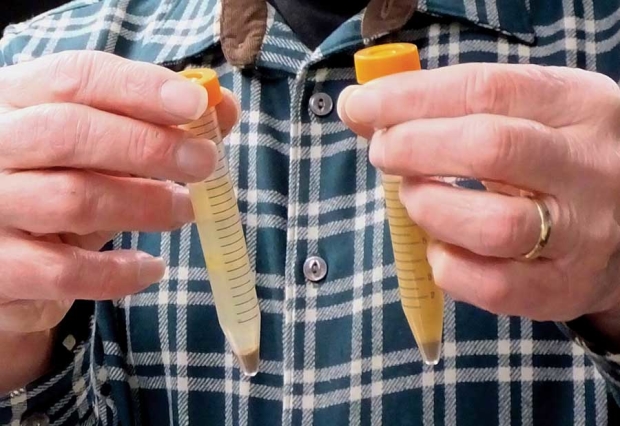
After giving two tubes of soil and water a gentle shake, Michigan State University professor and researcher George Bird compares how particles dissolve and how quickly the water begins to clear. This is a measure of water-stable aggregates, which he says is an especially good indicator of soil health. (Leslie Mertz/ for Good Fruit Grower)
Putting definitive numbers on measures of soil health is a tricky business, because what’s good for one soil type may not be good for another.
“I wish I could say we have set limits, but we can only give our best expert opinion at the moment,” said Dr. George Bird, a soil researcher at Michigan State University.
Currently, the “best expert opinion” is in a state of flux because the whole concept of soil health is a new area that is in need of more research, including testing in commercial orchards.
In the meantime, however, growers need some standards against which they can gauge their soils and determine how to manage them for the coming season.
With that in mind, Bird offered the following ranges for the coarse-textured orchard soils common in Michigan, but acknowledged that they are indeed estimates and demand additional field validation:
—Percentage of water stable aggregates: greater than 45 percent
—Soil moisture potential: greater than 0.175 g/g
—Surface hardness: less than 150 psi
—Subsurface hardness: less than 300 psi
—Soil organic matter: usually greater than 3.5 percent
—Active carbon for nutrient mineralization: greater than 450 ppm
—Nitrogen mineralization potential: greater than10 µgN/g of dry-weight soil/week
—Appropriate levels of all other chemical elements for crop growth and development: phosphorus (5-25 ppm), potassium (45-75 ppm), magnesium (greater than 33 ppm), iron (less than 25 ppm), manganese (less than 50 ppm), and zinc (less than 25 ppm).
Regardless of their soil type, all growers should start using the new and more detailed soils tests that are available and log the resulting data from season to season, Bird said.
“You really need to use one of these electronic tracking devices — not a napkin from the local coffee shop — and record the parameters so you can follow your soil health over time,” he said.
From there, growers can analyze the data so they can make informed decisions about strategies that will either maintain or improve the health of their soil, and consequently, increase the health and productivity of their orchards and vineyards.
– by Leslie Mertz, Ph.D., a freelance writer based in Gaylord, Michigan.






Leave A Comment